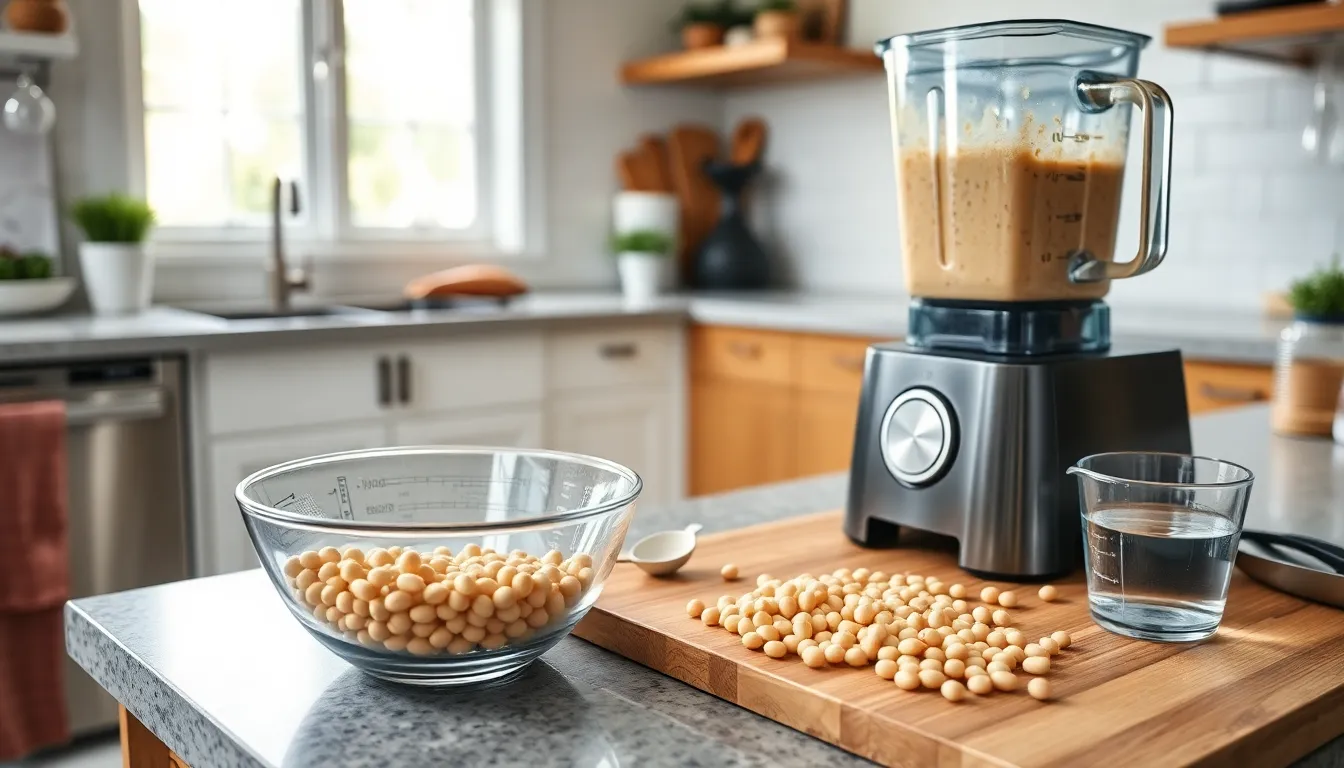Tofu often gets a bad rap, but it’s time to change that perception! Imagine whipping up a fresh batch of creamy, delicious tofu right in your kitchen. Not only will it impress your friends, but it’ll also make you the ultimate kitchen wizard. Plus, making tofu at home means you can customize it to your heart’s content—no more bland blocks that taste like cardboard!
With just a few simple ingredients and a little bit of patience, anyone can master the art of tofu-making. It’s a fun project that’ll have you feeling like a culinary genius. So roll up those sleeves and get ready to transform soybeans into a versatile protein that’s perfect for stir-fries, salads, and even desserts! Who knew being a tofu aficionado could be this much fun?
Table of Contents
ToggleIngredients Needed
Making tofu at home requires a few essential ingredients and equipment. With the right components, anyone can create delicious, fresh tofu.
Soybeans
Soybeans form the foundation of tofu. One cup of dried soybeans produces about two cups of soy milk, sufficient for crafting a block of tofu. Purchasing organic soybeans ensures higher quality and better flavor. When selecting soybeans, look for smooth, whole beans without blemishes or cracks. Soaking the beans overnight makes them easier to blend and extract milk.
Coagulants
Coagulants are crucial in the tofu-making process. Common options include magnesium chloride, calcium sulfate, and lemon juice. Each coagulant affects the texture and flavor of the final product. For instance, calcium sulfate yields a firmer texture, while magnesium chloride creates a creamier consistency. Using the correct coagulant in the right amount is essential for achieving the desired tofu firmness.
Equipment
Essential equipment simplifies the tofu-making process. A blender is necessary for puréeing soaked soybeans into a smooth mixture. Cheesecloth or a nut milk bag helps strain the soy milk from the solid soy pulp. A tofu mold, which shapes the tofu during pressing, ensures even consistency. Additionally, a heavy object acts as a weight for pressing tofu, allowing it to remove excess moisture effectively. Investing in these tools streamlines the tofu-making experience.
Preparing the Soybeans

Preparing soybeans is the first step in making tofu at home. This process involves soaking, blending, and utilizing the right tools.
Soaking the Soybeans
Soaking dried soybeans is essential for achieving a smooth texture. Aim for a duration of 8 to 12 hours to allow the beans to swell and soften. High-quality organic soybeans absorb water evenly, leading to better blending. After soaking, rinse the soybeans under cold running water to remove any impurities. This rinsing step ensures a clean foundation for the tofu.
Blending the Soybeans
Blending the soaked soybeans creates a smooth mixture, which forms the basis for the tofu. Start by draining the soaked beans and adding them to a blender. Use approximately 3 cups of water for every cup of soaked soybeans to achieve the right consistency. Blend until the mixture reaches a creamy texture, ensuring there are no large chunks. This smooth blend enhances the overall quality of the tofu.
Making the Soy Milk
Making soy milk is a crucial step in the tofu-making process. This stage allows for the extraction of rich flavors and creamy textures.
Cooking the Mixture
Cooking the blended soybean and water mixture holds significant importance. Start by pouring the mixture into a large pot and heating it over medium heat. Stir the mixture continuously to prevent burning. Once it reaches a gentle boil, reduce the heat to maintain a simmer for about 5 to 10 minutes. This cooking process enhances the flavor while also breaking down proteins and fats, contributing to a smooth consistency. Be cautious, as the mixture can bubble and spill over if not monitored carefully.
Straining the Soy Milk
Straining the soy milk separates solids from liquids, producing a smooth product. Use a cheesecloth or nut milk bag placed over a bowl to facilitate this process. Carefully pour the cooked mixture into the cloth or bag. Gather the edges and squeeze firmly to extract as much liquid as possible. This step ensures the soy milk is free from grainy textures, resulting in a silky finish. Retain the leftover soy pulp, known as okara, as it serves as a nutritious ingredient in various recipes.
Coagulating the Soy Milk
Coagulating soy milk forms the basis of tofu production. Selecting the right coagulant is crucial for achieving the desired texture and flavor.
Choosing the Right Coagulant
Magnesium chloride and calcium sulfate are the most common coagulants. Magnesium chloride, also known as nigari, imparts a delicate, creamy texture to the tofu. Calcium sulfate provides a firmer consistency, making it ideal for dishes requiring sturdy tofu. Each coagulant offers distinct benefits: magnesium chloride often contributes a slightly savory taste, while calcium sulfate tends to enhance silkiness. Understanding the intended use of tofu can influence coagulant selection, so he recommends experimenting with both to find a preferred texture.
Adding the Coagulant
After preparing the soy milk, it’s time to add the coagulant. Dissolve the chosen coagulant in a small amount of warm water before incorporating it into the soy milk. Gradually stir the mixture to ensure even distribution of the coagulant. Maintain gentle stirring as curds begin to form. Allow the mixture to sit undisturbed for about 10 minutes, giving it time to fully coagulate. This step is essential for creating the proper curds and whey separation needed to form tofu effectively.
Pressing the Tofu
Pressing tofu is a vital step that removes excess moisture and enhances texture. A well-pressed block results in firmer tofu, improving its ability to absorb flavors.
Molding the Tofu
Molding tofu shapes it into a cohesive block. Once curds form, the next step involves transferring them into a tofu mold lined with cheesecloth. Properly packed curds minimize air pockets, promoting an even texture. The mold’s inner shape determines the tofu’s final appearance. After filling the mold, fold the cheesecloth over the top, creating a neat package.
Pressing Techniques
Pressing techniques vary but focus on applying consistent weight. Using a heavy object, like a cast iron skillet, effectively removes moisture. Techniques can also include a specialized tofu press for controlled pressure. The pressing duration ranges from 15 to 30 minutes, depending on personal preference. Allowing enough time ensures achieving the desired firmness, which impacts cooking and flavor absorption.
Storing and Using Tofu
Properly storing tofu extends its freshness and maintains quality. Refrigeration is essential for all tofu varieties. Fresh tofu keeps well submerged in water within an airtight container; this method retains moisture and flavor. Changing the water every couple of days prolongs its lifespan.
Storage Tips
Tofu can stay fresh for up to a week in the fridge when stored correctly. Freezing is an option for longer storage, changing the texture to be firmer and chewier. Thawing takes several hours in the refrigerator, allowing it to absorb marinades better during cooking. Labeling containers with storage dates ensures that it remains safe to consume.
Cooking with Tofu
Versatility defines tofu in many dishes. Sautéing brings out its texture, allowing it to absorb surrounding flavors. Utilizing marinades enhances taste; a soak of at least 30 minutes often yields the best results. Adding tofu to stir-fries, soups, or salads provides a protein-packed option. Baking or grilling creates a deliciously crispy exterior, making it suitable for diverse cuisines.
Making tofu at home opens up a world of culinary possibilities. It’s not just about creating a versatile protein source; it’s about enjoying the process and customizing flavors to suit personal preferences. With the right ingredients and equipment, anyone can master this rewarding skill.
Homemade tofu can elevate meals while offering a fresher taste compared to store-bought options. By experimenting with different coagulants and pressing techniques, individuals can discover their ideal texture and flavor profile.
Whether it’s added to stir-fries or grilled for a crispy finish, homemade tofu is sure to impress. Embracing this craft not only enhances cooking skills but also leads to healthier meal choices. So why not give it a try and enjoy the delicious results?




